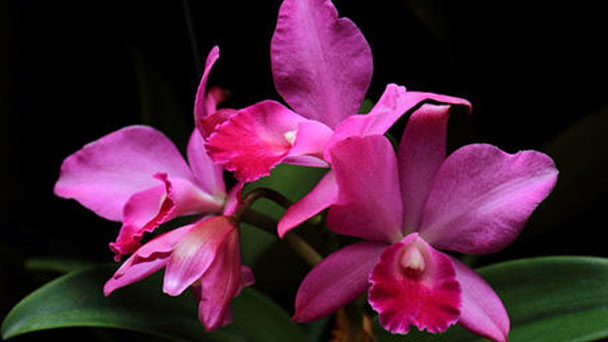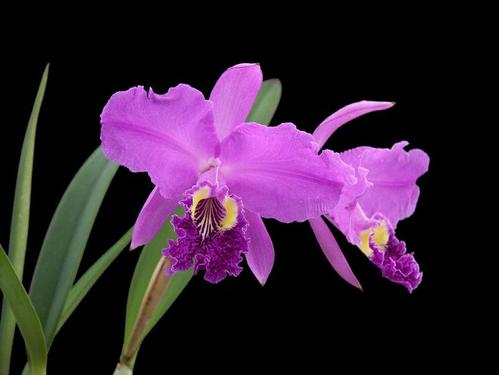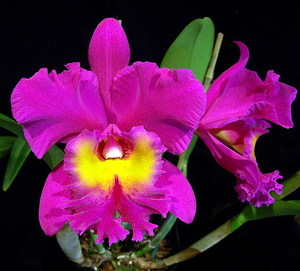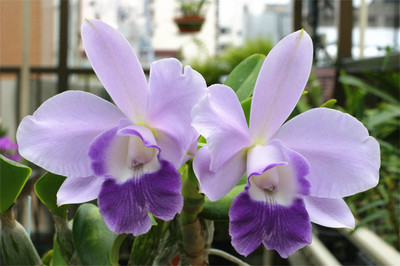Cattleya orchid profile
Written by Maggie
Mar 31 2021

Cattleya orchid, also known as corsage orchid, Queen of the Orchids, a horticultural hybrid, is one of the most famous orchids in the world. There are more than thousands of varieties. The color is white, yellow, green, red, purple and so on. Propagation is by dividing, tissue culture, or aseptic seeding. Cattleya orchid likes warm, damp and plenty of light. They are usually potted with fern roots, moss, bark chunks, etc. The growth period requires high air humidity, proper fertilization and ventilation.
Cattleya orchid picture

Cattleya orchid info
| Botanical Name | Cattleya |
| Common Names | Cattleya orchid, orchid, corsage orchid, Queen of the Orchids |
| Plant Type | Perennial |
| Sun | Partial |
| Hardiness Zones | 10–12 (USDA) |
| Flower color | All colors except true blue |
| Native Area | Central America, South America |
| Mature size | 0.25–2 ft. tall and wide |
Morphological characteristics of Cattleya orchid
Cattleya orchid is evergreen, with clublike or cylindrical pseudo scales, fusiform pseudobulbs, plant height above 25 cm; A stem has 2 to 3 leaves, thick leaves were long ovate. General autumn blooms once, some can bloom 2 times, there are different varieties of flowering throughout the year. Pedicels are 20 cm long, with 5 to 10 flowers, large flowers, about 10 cm in diameter, with a special aroma, each flower can open continuously for a long time; In addition to black, blue, almost all colors, beautiful, there is the "king of orchids" title.
Cattleya orchid can be divided into single leaf species and double leaf species. Propagation is by dividing, tissue culture, or aseptic seeding.Winter temperature 15 ~ 20℃. It blooms once or twice a year, and the flowering period is usually about 3 to 4 weeks.
Cattleya Orchid is a perennial herbaceous plant belonging to epiphytic orchid, with annual evergreen. Plant with 1 to 3 thick leathery leaves, is the storage of water and nutrient tissue.
Available broken fern root 6, vermiculite 1, plus charcoal and gravel. Transplanting is best done after the dormant period.
Ecological habits of Cattleya orchid
Cattleya orchid is a perennial herbaceous epiphyte that attaches to the branches of large trees. Cattleya orchid likes a warm and humid environment, winter temperature, night about 15℃, 20 ~ 25℃ in the daytime, to maintain a large temperature difference between day and night is very important, can not be constant temperature day and night, but not higher than the night temperature. Cattleya orchid requires a half overcast environment, chunxia qiu 3 seasons should block the light that goes 50% ~ 60%.
Cattleya orchid prefers warm, moist conditions, where the leaves and pseudobulbs are dark green, shiny and vibrant. The flower bud can grow smoothly, the flower is in full bloom, and the color is gorgeous. New roots and shoots are flourishing. If the temperature is about 11℃, the flowering date will be delayed, the flowers will not fully bloom, and the flowering date will be short. If the temperature is about 5℃, the leaves appear yellow, dull, longitudinal wrinkles of pseudobulbs, flower buds can not grow, grow tall, and the flower sheath becomes brown, the growth is seriously hindered. If the temperature drops to 1 ~ 2℃, leaves yellow or brown and fall off, buds die. Of course, if the nighttime temperature is higher than 20℃, the flowering period is often too short. In greenhouse cultivation in northern China, special attention should be paid to maintaining a large temperature difference between day and night, so that the greenhouse temperature in the daytime is 5 ~ 10℃ higher than that at night. The temperature should not be the same day and night, and the temperature should not be higher at night than in the daytime.
How to grow and care for Cattleya orchid
Place
Do not have to Cattleya orchid shed or greenhouse, in the balcony, roof planting can also be.
Llight
Light is the most important factor for the robustness and flowering of Cattleya orchid plants, whether they are grown in a greenhouse or in a house. Lack of sunlight can lead to delayed flowering or low flowering rates. Cattleya orchid requires a lot of light and allows direct sunlight to reach the plant except at midday. Cattleya orchid can be placed in the east and shaded south windowsill, in the west windowsill can also be raised. If it is greenhouse cultivation, should be shading to full light 50% ~ 70%. The leaves should be medium green and the pseudobulbs erect if the light is good. But some species do not need as much sunlight, such as dark vermilion flowers that bloom in winter and small mini flowers.
The temperature
Cattleya orchid grows best at 21 ~ 30℃ in daytime and 15 ~ 16℃ at night. The best night seedling at 18 ~ 21℃. For Cattleya orchid, especially mature plants, a diurnal temperature difference of 6 to 10 degrees is desirable. Cattleya Orchid can tolerate temperatures of up to 35 ° C and should be ventilated and shaded if humidity is high.
Watering
Water should be done in two ways: by pouring water into the basin and by humidifying the air. The amount of water you pour depends on many factors: pot size, material, temperature, light, and so on. Mature Cattleya Orchid plants should be watered after the plants have dried, while young plants require a relatively constant moisture level. A growing plant needs more water than a dormant plant. Take care to stop watering when the cold snap strikes.
Humidity
Cattleya orchid is best suited for RH of 50% to 80%.Greenhouse cultivation had better use humidifier to carry on humidify, bedroom cultivation can put flowerpot seat on the plate that has gravel shop, a few water is put in the plate, cannot let the root of the plant contact water. At ordinary times, especially in high humidity or low temperature conditions, air should be kept circulating to prevent fungi and bacteria.

Fertilizer
If it is potted, apply a balanced proportion of compound fertilizer; If the cultivation is by hanging on a snake board, use a compound fertilizer with a high nitrogen ratio (e.g. N: P: K 30:10:10). Fertilizing the Cattleya orchids at least once every two weeks during the vigorous growth season;If you are not in that period, apply fertilizer once a month. The concentration is usually diluted with water at 1/2 or 1/4 of the recommended concentration. It is recommended that the plants be thoroughly rinsed with clean water once a month to prevent the accumulation of salt in the fertilizer.
Basin
When the roots of the plants have grown outside the edge of the basin or the substrate in the basin has begun to collapse, drainage is not smooth, then should be replaced in time. This usually occurs after two years of cultivation. The best time to change the pot is after the spring flowering, when the new roots have not yet developed.
Mature Cattleya orchids usually use a larger piece of material than young plants; When the Cattleya orchid grows to at least six mature pseudobulbs, it can be replaced with a larger pot without dividing the plants. If you want to multiply in separate plants, each pot should contain at least three to five pseudobulbs.The size of the basin should not be overgrown for about two years.
The propagation of Cattleya orchid
In March, just after the new bud germination or flowering, the base rhizome should be cut open. Each cluster should have at least 2-3 pseudobulbs with new buds. The cluster should not be too small, otherwise the new plant will recover slowly and blossom late.
Propagation methods of Cattleya Orchid include plant division, tissue culture or aseptic seeding. Cattleya orchid likes warm, damp and plenty of light. Because it is an epiphytic orchid, the root needs to keep a good air permeability, and the temperature at night in winter should be kept at about 15 ~ 18℃, and it is higher in the daytime.It blooms once or twice a year, and the flowering period is usually 3 to 4 weeks. When planting with fern root peat moss, it must be tightly planted, with a portable plant, the root is not pulled out from the pot as well. Roots should be evenly dispersed in the pot material. Finally, use scissors to cut the basin surface cultivation materials flat, the middle slightly raised as well. When planting with bark blocks or ash or broken bricks, the lower part of the pot should be made of granulated material to facilitate drainage and ventilation. The upper part, especially the basin surface should be put in small particles of material, in order to maintain the humidity in the basin.
Propagation is done by branching, tissue culture, or seeding without bacteria. Cattleya orchid likes warm, damp and plenty of light.Winter temperature 15 ~ 18℃. Cattleya orchid is cultivated using peat moss, fern roots, bark chunks or broken bricks as pot material. When planting, the pot bottom is filled with some large particles of broken bricks and charcoal blocks, and then the roots of Cattleya Orchid are planted in porous mud pots with a mixture of two parts of fern root and one part of peat moss, or processed into 1cm diameter of dragon's eye bark and oak bark. These potting materials should be soaked with water before use.
Species taxonomy of Cattleya crchid
For example 'Red Waxy', there have also been hybrids between Cattleya Orchid and other related genera such as' Pinky ', 'Meili', 'Small wood', 'Kimbilly', 'Heredity' and 'Sherry', as well as hybrids between related genera of Cattleya Orchid.
In addition, Cattleya Orchid can be divided into monochrome and polychrome flower types according to flower color, as well as large, medium, small and miniature flower types according to flower size.
Flowering time of Cattleya Orchid varies greatly among different cultivars.
It is winter flower as early as possible spring flower breed, flowering period is more in January to March between, breed has' big eye ', 'trichromatic', 'young lady of California,' lemon tree, 'ocean harbor', 'red rose' etc.
The second is the variety of late spring flowers, the flower period in April to May, varieties of 'Ruby', 'Girl', 'Sanyang', 'Big Brother', 'Lingxiang', 'Dream come true' and so on.
The third is the summer variety, the flowering period between June and August, varieties such as' Dashuai ', 'Akifen', 'Helen Brown', 'Chinese Beauty', 'Yellow Quill' and so on.
Fourth, autumn and winter flower varieties, flowering between October and December, varieties such as' Jin Chaoqun ', 'Sapphire', 'Red Ba Tu', 'Yellow Diamond', 'Green', 'Qiuweng', 'Autumn Light', 'Ming Star', 'Green Virgin' and so on.Fifth, irregular varieties, flowering period is not restricted by season, such as' Victory ', 'Golden Butterfly:,' Doll 'and so on.
The distribution of Cattleya orchid
Cattleya orchid, native to tropical America, is an epiphytic orchid that often grows on trees or undergrowth rocks in forests.
Garden use of Cattleya orchid
Cattleya Orchid is a gorgeous flower with various shapes and colors. It is often used for flower arrangement on festivals and banquets. For example, Cattleya Orchid and Phalaenopsis orchid are used as the main materials, and paired with the vase of Wenxin orchid, jade bamboo and asparagus, they are bright and elegant with strong rhythm and charm. If Cattleya Orchid is the main flower, it will be light and lively if it is paired with carnation, porous tortoise back, bamboo and bear grass. Cattleya orchid is one of the most popular orchid species. The flowers are big and colorful, unique and beautiful, with rich changes in colors and extremely magnificent, and it has the reputation of "Queen of Orchids". And long flowering period, a flower can open for about 1 month; Cut flowers can be appreciated for 10 to 14 days.

Latest Updated
- Benefits of Bugleweed - 7 Science-backed Health Benefits
- Bugleweed Dangers & Side Effects - Is It Poisonous?
- How to Plant Evergreen Trees - What You Should Know
- When to Plant Evergreens - Grow Guide for Evergreen Trees
- 12 Wonderful Evergreen Shrubs for Your Garden
- 12 Popular Evergreen Plants with Pictures for Beginners
- When And How To Prune A Lilac Bush Like a Pro
- How to Grow & Care for Lilac Vine (Hardenbergia Violacea)
- Japanese Lilac Tree (Syringa Reticulata) Care & Propagation Guide
- Shumard Oak Pros and Cons - What to Know
Popular Articles
- Winter maintenance of Antirrhinum Majus
- How to Grow Terminalia Mantaly Tree
- How to Grow and Care for Crossostephium Chinense
- How to grow Antirrhinum Majus in spring
- Peristeria Elata (Dove Orchid) Profile: Info & Care Guide
- Underwatered Snake Plant (Sansevieria Trifasciata) - Signs And How To Fix
- How to Care for Brazilian Jasmine Plant (Mandevilla Sanderi)
- How to Grow & Care for Graptopetalum Purple Delight in Summer
- Rosa Chinensis (China Rose): Plant Growing & Care Tips
- How to Care for Baby Sun Rose (Aptenia Cordifolia)